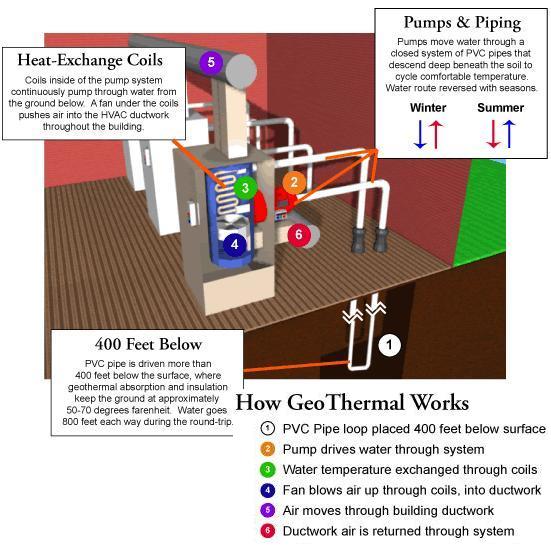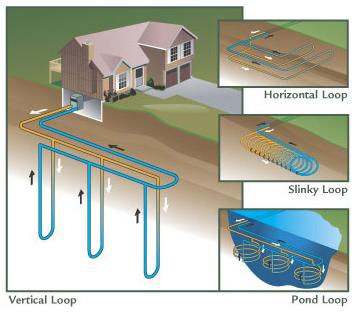|
GEOTHERMAL COMFORT SYSTEMS
| |||||
|
|
Open loop systems
Open loop systems generally are used in conjunction with a potable water well, and used in combination with a pond or lake. In a pond or lake, the loops are attached to a frame or rack and then lowered to the bottom.
This type of system involves the ground water table, which means that approvals from your local authorities will most likely be mandatory before installing such a system.
Your Geothermal contractor will advise you as to your best approach, depending upon your land acreage, potable water availability, soil conditions, and overall installation economy.
Bonus: Free hot water
With the installation of a storage tank and a heat exchanger, called a desuperheater, the residence’s hot water needs can be supplied most of the time, as a byproduct of the heating or cooling process. The system must be producing heating or cooling to produce hot water. A secondary conventional water heater is often installed for supplemental needs.
The most common type of heat pump for this application is the
Ground-Source-Heat-Pump.
Click on this link to read more about the ground-source-heat-pump. This link will take you to our GSHP page, where more detail can be found about the actual heat pump operation.
There are variations of the conventional ground-source-heat-pump, which have been developed for non-conventional geothermal installations.
- Hybrid or split system still utilizing a furnace or air handler for distribution
- Outdoor Geo unit. This unit is placed outside replacing the old conventional heat pump or condensing unit. The geothermal loop system is completely outside. A refrigerant loop connects the outdoor unit to a coil at the furnace or air handler.
- Direct expansion units. In this system the refrigerant lines become the geothermal loops. The freon flows through copper lines buried in the earth to accomplish the heat transfer.
A bit of history
The belief that Geothermal technology is new, is a misconception. In actuality, the principle of utilizing water and the earth’s constant temperature for heating and cooling our homes has been around since 1855, in Austria. Other variations of this concept date back to Roman times.
The EPA estimates that there are in excess of one million geothermal units in operation in the US today. A non-profit organization, IGSHPA (International Ground Source Heat Pump Association) has been in existence since 1987, to help advance Geothermal technology.
Amazing numbers
- For every 100,000 geo units in operation, 37.5 trillion btu’s of energy used for space and water heating can be saved.
- For that same 100,000 geo units in operation, operational cost savings to consumers range up to $750 million over the 20-year-life of the equipment.
- For every 100,000 geo units, foreign oil consumption is reduced by 2.15 million barrels annually and electricity consumption is reduced by 799 million kilowatt hours annually.
- Economical. Homeowners can save 25 to 50 percent on home electric bills compared to the conventional heating and cooling systems. Electric bills for a 2,000 sq. ft. home can be reduced to as low as $1 a day. Savings to homeowners range between 30 to 70% in the heating mode and 20 to 50% in the cooling mode, compared to conventional systems
- The U.S. General Accounting Office estimates that if geothermal systems were installed nationwide, they could save several billion dollars annually in energy costs and substantially reduce pollution
- Green house gas emissions are reduced worldwide
- Geo units produce no onsite emissions
- Ground source heat pumps are an average of 48% more efficient than the best gas furnaces, and over 75% more efficient than oil furnaces
- Surveys by many utility companies indicate a higher level of consumer satisfaction for geothermal systems than for conventional systems. Polls consistently show that more than 95% of all geothermal customers would recommend this type of a system to a family member or friend.
- Elimination of more than 5.8 million metric tons of CO2 annually
- Elimination of more than 1.6 million metric tons of carbon equivalent annually
- Annual energy savings of nearly 8 billion kWh
- Annual savings of nearly 40 trillion Btus of fossil fuels
- Reduced electricity demand by more than 2.6 million kW
- Taking close to 1,295,000 cars off the road
- Planting more than 385 million trees
- Reducing U.S. reliance on imported fuels by 21.5 million barrels of crude oil
Portions of the above text have been reproduced from superior geo sources such as the
EPA,
the
Dept. of Energy,
and
IGSHPA.
The reader considering a Geo Hvac installation or interested in more detail about these systems or ground source heat pumps should visit these sites.
Other Related Pages
Ground Source Heat Pumps: Mother Earth Will Wrap You In Warmth
Heat Pumps
Heat Pumps Pros and Cons
Leave Geothermal and Return to HOME
Please feel free to link to this page from your website. This page's URL is: http://www.perfect-home-hvac-design.com/geothermal.html





















 In order to tap into this great storage container, high strength polyethylene pipes are buried in the ground. Then water or a glycol/water mixture is circulated through the piping loops to either pick up heat during the winter, or to dissipate heat into the ground during the summer months. Then the liquid is pumped to the Geothermal heat pump for comfort system distribution inside.
In order to tap into this great storage container, high strength polyethylene pipes are buried in the ground. Then water or a glycol/water mixture is circulated through the piping loops to either pick up heat during the winter, or to dissipate heat into the ground during the summer months. Then the liquid is pumped to the Geothermal heat pump for comfort system distribution inside.
 Closed loop systems can also be installed in vertical shafts drilled for the piping loops. In the vertical loop system, the pipes are installed vertically, or like a slinky, in a series of vertical tunnels drilled down 60 to 200 feet deep. Then the tunnels are filled with grout ensuring good heat transfer to the surrounding ground. This method can become expensive to install, due to the specialized drilling required.
Closed loop systems can also be installed in vertical shafts drilled for the piping loops. In the vertical loop system, the pipes are installed vertically, or like a slinky, in a series of vertical tunnels drilled down 60 to 200 feet deep. Then the tunnels are filled with grout ensuring good heat transfer to the surrounding ground. This method can become expensive to install, due to the specialized drilling required.


